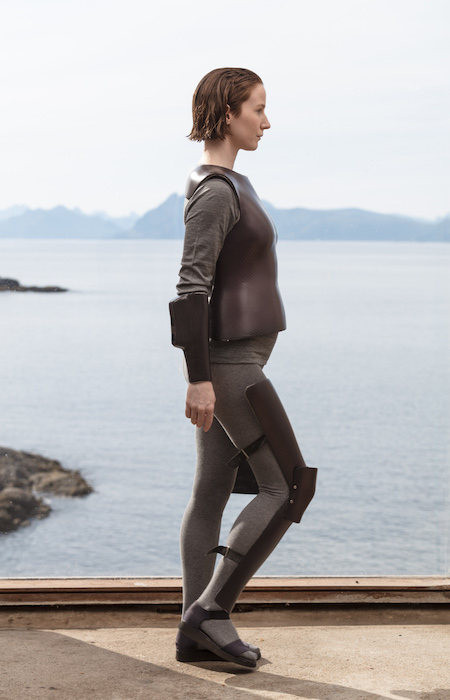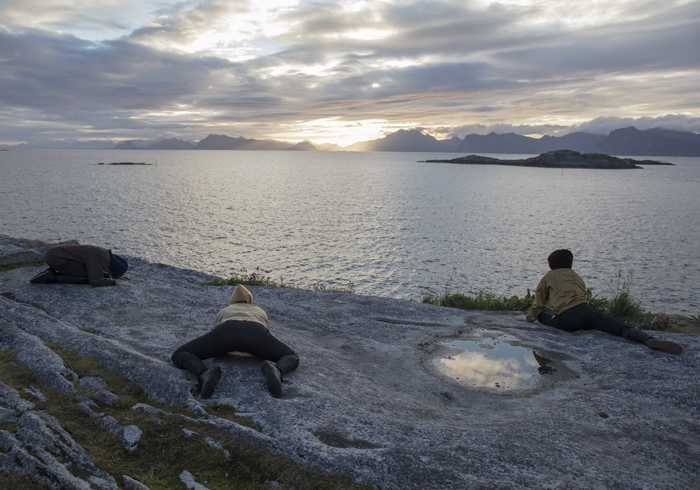In a natural landscape as distracting as this, it’s hard to be critical of much of anything. Standing on a rocky, moss-covered outcrop overlooking the vast clear waters of this Norwegian archipelago, you feel as though you’ve inadvertently stepped into a painting by Caspar David Friedrich. That this cluster of wooden houses in a fishing village of 460 inhabitants within the Arctic circle could be the location of an international festival of contemporary art seems incongruous; in fact, the Lofoten International Art Festival has been running every two years since 1999, attracting thousands of local and regional visitors to this remote location for the month of September. Each edition invites one local and one international curator to present a theme that reflects on the context; unsurprisingly, the question of oil (Lofoten is the only place in Norway you can’t currently drill for oil) and the fishing that sustains these communities tend to dominate the conversation. For the first time, this year’s festival takes place on the island of Henningsvær. It is centred around Trevarefabrikken, a factory-turned-creative space that has been instrumental in the development of this island’s small artistic community, extending into two precarious wooden buildings, an outdoor stadium and community kitchen. Curators Heidi Ballet and Milena Høgsberg have conceived I Taste the Future, an exhibition that engages with science fiction as a tool for thinking about possible futures without succumbing to apocalyptic scenarios, asking artists to imagine life in this remote landscape 150 years from now.
can artists really be tasked with seeing into the future when the rest of us cannot?
It’s been said that science fiction is employed as a mechanism at a moment in which other possible futures are impossible to comprehend. The current appetite for science fiction in contemporary art stems from its ability to reconsider the past and present through future projection; after all, our fears for the future stem from contemporary conditions. Ballet and Høgsberg’s theme is therefore pertinent in our current moment, both politically and ecologically, and feels relevant in a location facing pressing questions of global importance. But can artists really be tasked with seeing into the future when the rest of us cannot?

Through a strong selection of works, this small biennial of some 20 artists navigates these questions, if not without some tension between artworks and the curatorial proposition. Around half of the works are new commissions, mostly video and performance. In To Gear a Joan (2017), choreographer Adam Linder presents a standout work in the form of a ‘wearable libretto’ written for Norweigan vocalist Stine Janvin Motland. As she walks through Trevarefabrikken and onto the streets of Henningsvær in a suit of armour, Motland sings to an army of ‘Joans’ to rally against the culture of Western rationalism that has led to the plundering of natural resources: ‘Joans are going in. Joans have grown thicker skin.’
Presented in the Nordbrygga cod-liver oil factory by the water, Marysia Lewandowska and Neil Cummings’ unsettling video piece Museum Futures: Distributed (2008) stages a fictional interview with a future Moderna Museet’s executive director, on the occasion of the museum’s centenary in 2058. It’s not quite 150 years into the future, but the work’s vision of the fully networked museum ‘v2.0’ presents a shrewdly critical yet conceptually nuanced take on the future of art institutions. Contemporary discourses around the museum as a space of co-production and research are projected to a logical conclusion in a genealogy that reimagines the institution becoming an active agent in cultural and social processes, prototyping new forms of consciousness. In the same venue, Ho Tzu Nyen’s video The Critical Dictionary of Southeast Asia Vol.3 (2017) is one of the strongest works in the festival. The result of several years of research, it considers the question of what unites a region never connected by a single language, culture, religion or political entity. A dictionary of terms from A to Z acts as a mapping device through a rapid sampling of audio and visual imagery: ‘C for corruption, C for cultural kinship’. The work employs an algorithmic editing system created by the artist, collating a database of which no two viewings are the same. The work excels in presenting an alternate perspective on a little-understood region through a remixing of fragments of its past and present.
Many works sidestep the conventional tropes of science fiction to instead open up new ways of thinking about our relation to time
References to Donna Haraway abound, turning around a 90-minute video-portrait of the influential American theorist by artist Fabrizio Terranova in the central venue of Trevarefabrikken. Haraway’s A Cyborg Manifesto (1984) reappears in Lili Reynaud-Dewar’s video TEETH, GUMS, MACHINE, FUTURE, SOCIETY (TGMFS) (2016), which appropriates the ‘grill’ (a gold or platinum dental accessory worn as a status symbol in American hip-hop culture) to evoke the cyborg, a future human composed of both natural and technological elements. Reynaud-Dewar’s use of science fiction thinking as a means to reflect on contemporary issues of gender, race and class in the US points to one of the strongest threads running through the festival. The majority of works rethink the past and present, offering varied and often underrepresented perspectives on current political and social issues. In addition to Reynaud-Dewar’s video, other works reference contemporary concerns closer to the context of Lofoten: the inclusion of Silje Figenschou Thoresen’s work Vandret linje II (2017), for example, highlights debates around the cultural heritage of the Sámi people. Filip Van Dingenen’s presentation of his research into seaweed and interspecies diplomacy in participatory workshops and the series Tidal Migration Pattern of Seaweed Spirit When Moon is Shining (2016–17) is also relevant here, sitting well beside the more technologically focused works.
It is the articulation in Haraway’s work of science fiction thinking, as opposed to apocalyptic future projections, that resonates most strongly in the commissioned works and arguably presents the most nuanced responses to the festival’s theme. Haraway argues that we need to tell new stories to counter the age-old narratives that define our present and future condition. Many works in the festival take up this call, often sidestepping the conventional tropes of science fiction to instead open up new ways of thinking about our relation to time. Of particular note is one of the only works taking place outside, artist Daisuke Kosugi’s Good Name (Bad Phrase) (2017), situated within the Henningsvær Stadion, an open sports arena surrounded by cliffs. Using an audio guide, participants are prompted to move around the space in response to short stories on the concept of death. The result is a choreographed social performance that offers a novel way to explore the terrain. Influenced by his background working in insurance, Kosugi is interested in the futility of assessing risk, and the impossibility of humans understanding a world in which they don’t exist. This very human, narrative work actively refuses to look into a technological future, focusing instead on how humans attempt to think about the future from their present.
The festival admirably attempts to grapple with questions of futurity we are all struggling to answer through an interesting, if not groundbreaking, theme. Where it perhaps falters is in its brief to artists to imagine the future of this area 150 years from now. This fairly literal question works against the festival’s more sophisticated thinking around science fiction. To their credit, the curators allowed the commissioned works to interpret the brief in a way that went beyond its limited parameters, responding to this place on the periphery as a site of potentiality to open up more imaginative ways of thinking through and about our present.
Online exclusive 8 September 2017
